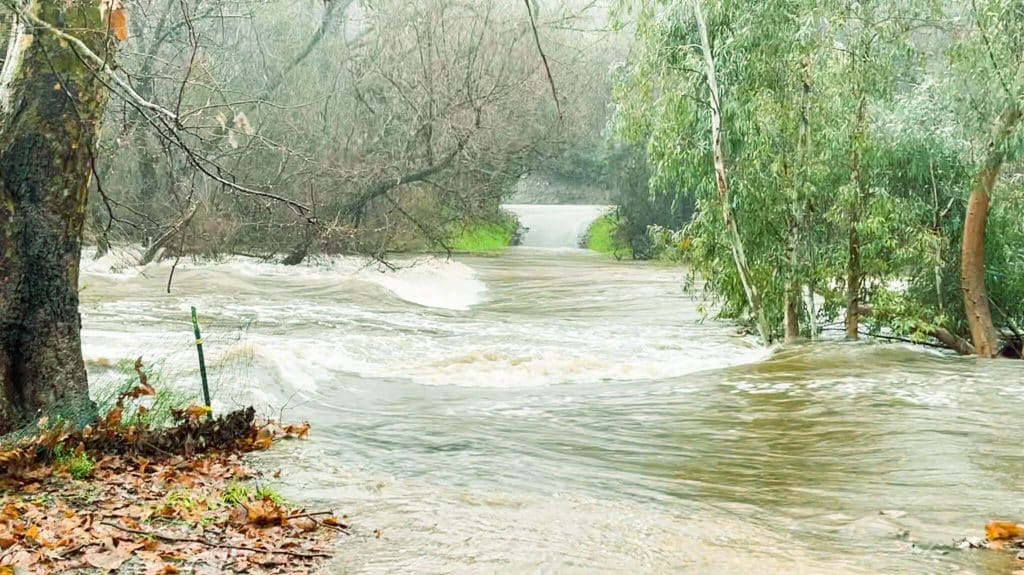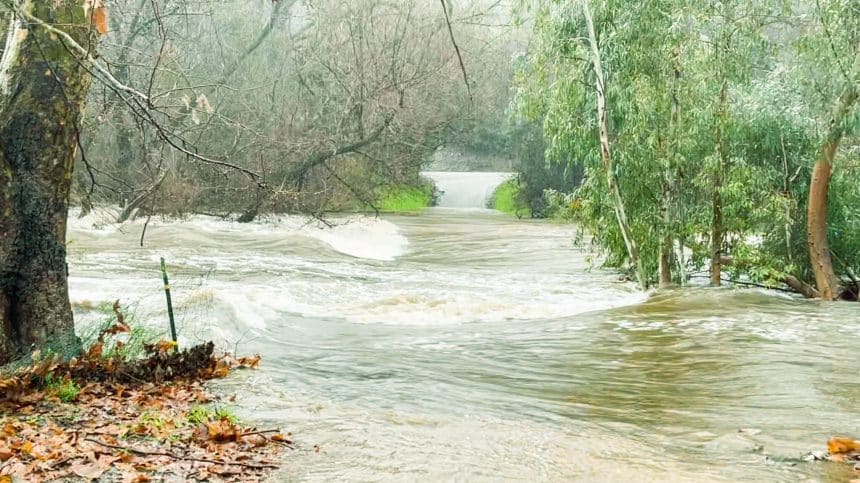RIVERSIDE Combined Sources — California’s 11th atmospheric river left the storm-soaked state with a bang Wednesday, bringing flooded roadways, landslides and toppled trees to the southern part of the state as well as drought-busting rainfall that meant the end of water restrictions for nearly 7 million people.
Even as residents struggled to clean up before the next round of winter arrives in the coming days — with some 27,000 people still under evacuation orders statewide Wednesday — the Metropolitan Water District of Southern California’s decision brought relief amid the state’s historic drought.
The district supplies water for 19 million people in six counties
Restrictions on water use were imposed in the face of dwindling reserves at the state level. At the beginning of December, the state Department of Water Resources announced that water agencies throughout the state would be receiving only 5% of the allocations they requested from the state.
But as winter storms began hitting the region and rain and snow replenished supplies, the state announced in January that it would deliver 30% of requested allocations. That figure increased to 35% in February.
“While we certainly appreciate the improved water supply conditions, I want to caution everyone that our challenges are not over,” MWD General Manager Adel Hagekhalil said in a statement. “We ask everyone to remain diligent in saving water regardless of the weather.
“We also continue to face major uncertainties on our water supplies from the Colorado River,” he said.
The federal government has directed California and six other states to develop plans to cut their reliance on Colorado River water beginning next year.
But weather woes remained Wednesday, as an additional 61,000 people remained under evacuation warnings and emergency shelters housed more than 650 people, according to the California Governor’s Office of Emergency Services.
Flooding also closed several miles of the Pacific Coast Highway through Huntington Beach, south of Los Angeles on the Orange County coast, and potholes disabled more than 30 cars on one Southern California freeway. More than 144,000 utility customers statewide remained without power Wednesday afternoon, according to poweroutage.us.
Gov. Gavin Newsom surveyed flood damage in an agricultural region on the central coast, noting that California could potentially see a 12th atmospheric river next week. Officials have not yet determined the extent of the winter storms’ damage, both structurally and financially.
“Look back — last few years in this state, it’s been fire to ice with no warm bath in between,” the Democrat said, describing “weather whiplash” in a state that has quickly gone from extreme drought and wildfires to overwhelming snow and rain.
“If anyone has any doubt about Mother Nature and her fury, if anyone has any doubt about what this is all about in terms of what’s happening to the climate and the changes that we are experiencing, come to California,” the governor said.
Remaining showers across Southern California were expected to decrease through Wednesday evening as the storm headed toward parts of the Great Basin. The weather service said California will see minor precipitation this weekend, followed by another substantial storm next week.
Three clifftop apartment buildings were evacuated Wednesday morning when earth slid away from their backyards in coastal San Clemente, the Orange County Fire Authority said. Residents were also cleared out of a nearby building as the severity of the slide was studied.
California was deep in drought before an unexpected series of atmospheric rivers barreled into the state from late December through mid-January, causing flooding while building a staggering snowpack in the Sierra Nevada.
Storms powered by arctic air followed in February, creating blizzard conditions that buried mountain communities under so much snow that structures began collapsing.
The water content of the Sierra snowpack is now more than 200% of the April 1 average, when it normally peaks, according to the state Department of Water Resources.
Michael McNutt, a spokesperson for the Las Virgenes Municipal Water District, said the end of the Southern California restrictions is good news but cautioned people to continue to conserve water even in non-drought years.
“We all know that the next drought is just around the corner,” he said Wednesday. “We’ve got to treat the water coming out of our taps as the liquid gold that it is.”
The district depends almost entirely on state water supplies and had adopted aggressive conservation measures, including putting devices that drastically restrict water flow onto the homes of hundreds of people — including celebrities — who were deemed to be wasting water.
That program is now on hold, as is the district’s restrictions on lawn watering.




Поиск в гугле
Es bietet über 6.900 Spiele, faire Bonusprogramme und mehrere Zahlungsoptionen wie E-Wallets, Kreditkarten und Kryptowährungen. Ein Beispiel für ein geprüftes und sicheres Casino ohne OASIS ist Magius, das im Jahr 2025 als besonders zuverlässig gilt. Online-Casinos ohne die deutsche Sperrdatei bieten im Jahr 2025 eine flexible Alternative für Spieler, die sich nicht an das OASIS-System binden möchten. Diese Funktionen sind freiwillig, bieten jedoch wertvolle Unterstützung, um Risiken zu reduzieren. Diese Anbieter ermöglichen häufig höhere Einsatzlimits und bieten Sonderaktionen zu großen Events, was zusätzliche Spielanreize schafft. Casinos ohne OASIS bieten eine große Auswahl an Slot-Spielen mit flexiblen Einsatzmöglichkeiten und höheren Gewinnpotenzialen.
Bereite dich darauf vor, mit über 90 aufregenden Spielautomaten zu spielen, die spannende Jackpots und endlosen Spaß bieten! Die Spielbank Bad Füssing bietet modernes Flair und ein abwechslungsreiches Angebot an Glücksspielen. Spielbank Bad Fussing Spieler können eine Vielzahl von Spielen erwarten, mit über 90 Spielautomaten, die Jackpots anbieten, neben klassischen Tischspielen wie Roulette, Blackjack und Poker. Als staatlich lizenziertes Casino sind wir stolz darauf, eine unvergleichliche Auswahl an traditionellen Tischspielen und modernen Spielautomaten anzubieten, die sorgfältig zusammengestellt sind, um selbst die anspruchsvollsten Geschmäcker zu bedienen. Das Spielbank Bad Füssing Online-Casino bietet eine Vielzahl von Tischspielen, darunter Roulette, Black Jack, Poker und Dice52. Natürlich spielen hier in nicht die Kurgäste an den Automaten oder an den Tischen, sondern auch Gäste aus den umliegenden Städten sowie Einheimische.
References:
https://online-spielhallen.de/verde-casino-bonuscode-25e-promo-2025-ubersicht/
Activating a bonus code at Casino Rocket is quick, straightforward, and works seamlessly whether you’re using a desktop or mobile device. Bonus codes are special alphanumeric phrases you enter during a deposit to trigger a specific promotional offer. Unlocking the Casino Rocket bonus code is essential for a journey filled with rewards, free spins, and extra cash. Play with total confidence at RocketPlay – Australia’s trusted casino brand for pokies and real money table games. Play pokies and casino games for real money on any device – no app download required! The RocketPlay online casino is fully optimised for iOS, Android and tablets.
For more information about the full welcome offerings available at leading casinos, check out our selection of the best free crypto sign-up bonuses with no deposit required. The site offers a wide range of promotions and bonuses for both new and existing players, including a generous welcome bonus and ongoing promotions such as 30 free spins and reload bonuses. Established in 2014, Bitstarz is a cryptocurrency casino that offers a wide range of games, including slots, table games, and live dealer games.
Don’t skip these bountiful deposit bonuses – deposit today and embark on your gaming journey at RocketPlay Casino! Choosing games with a high RTP and low volatility enhances your winning chances and optimizes your no deposit bonus. When maximizing your no deposit bonus, choosing the right games is crucial. By redeeming the code, you’ll instantly activate the bonus, allowing you to start playing and enjoying the fantastic range of games on offer. Once you’ve registered your account at RocketPlay Casino, it’s time to redeem your no deposit bonus codes.
References:
https://blackcoin.co/house-of-jack-casino-review/
Our platform has earned its reputation as the premier destination for players who demand more than just games – they seek genuine partnership built on transparency, security, and mutual respect. Track your gaming sessions, save favorite King Billy casino games, and resume play exactly where you left off. Our responsible gaming section provides direct links to professional organizations including BeGambleAware and GamCare, ensuring players have access to expert guidance and counseling services.
Revel in the seamless fusion of technology and autonomy, knowing your kingdom of fun is securely under your rule. Here, you can command a panoramic view of all active logins across your devices, making it easier than ever to manage your digital footprint in real time. Take the vibrant world of King Billy Casino wherever you go, with a mobile interface finely tuned to perfection. Stepping through the gates of King Billy Casino, your personalized dashboard unlocks a powerhouse of control and insight, central to your gaming dominion.
Independent testing laboratories including eCOGRA and iTech Labs audit King Billy Casino games quarterly, verifying RNG functionality and payout accuracy. Microgaming supplies progressive jackpot networks including https://blackcoin.co/mega-moolah-reviews-gambling-plays-for-big-wins/ series and diverse table game variants. NetEnt contributes iconic slots including Starburst, Gonzo’s Quest, and Dead or Alive 2, recognized globally for engaging gameplay and reliable mechanics.
casino con paypal
References:
http://www.leeonespa.com/bbs/board.php?bo_table=free&wr_id=7997
online slot machines paypal
References:
https://skillproper.com/employer/best-paypal-casinos-canada-2025/
casino mit paypal einzahlung
References:
https://macrorecruitment.com.au/employer/best-online-casinos-australia-top-aussie-real-money-sites-2025/
casino avec paypal
References:
https://divyangrojgar.com/employer/40-best-australian-online-casinos-for-real-money-in-december-2025/